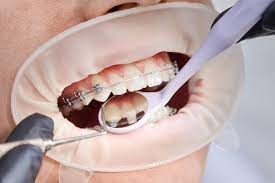One of the most common questions parents have when considering orthodontic treatment is when is the right time to start braces for kids? The decision to begin braces treatment depends on several factors, including the child’s age, dental development, and the severity of any issues with their teeth or bite. Understanding the ideal time for Dental Braces can help ensure that your child’s teeth develop properly and that the treatment is as effective as possible.
Early Evaluation, Why It’s Important:
The American Association of Orthodontists recommends that kids have their first orthodontic evaluation by age 7. This early evaluation helps identify potential problems and ensures that treatment begins at the right time. Here's why early evaluations are important:
- Early detection: Identifying issues early, such as crowding or bite problems, allows for timely intervention
- Monitoring development: Orthodontists can track the progress of your child’s teeth and catch any potential problems before they become serious
- Avoiding more invasive treatments: Early evaluation may reduce the need for more extensive treatment later on
An early visit to the orthodontist provides a proactive approach to managing your child’s dental health.
Ideal Age for Braces Treatment:
While there’s no one-size-fits-all answer to when kids should get braces, the ideal age typically falls between 9 and 14. However, the exact timing depends on the individual child’s development. Here’s what to consider:
- Age 9-11: This is often when early signs of orthodontic issues appear, such as bite problems or crooked teeth. Early treatment may be recommended to address these issues before they worsen
- Age 12-14: By this age, most children have their full set of permanent teeth, making it easier for the orthodontist to assess the need for braces and develop a treatment plan
Starting treatment during this window can help achieve the best possible results.
Types of Braces for Kids:
When deciding when to begin braces treatment, it’s also important to consider the types of braces available. The type of braces your child needs will depend on their unique dental needs. Some common types of braces for kids include:
- Traditional metal braces: The most common and affordable option, consisting of metal brackets and wires
- Ceramic braces: Similar to metal braces but less visible due to their tooth-colored appearance
- Invisalign: Clear aligners that are a popular choice for older children or teens, especially those who may feel self-conscious about wearing braces
- Lingual braces: Placed on the inside of the teeth, making them less noticeable
Each type has its own advantages and may be recommended depending on the child’s age and dental condition.
Signs Your Child May Need Braces:
Recognizing the signs that your child may need braces can help determine the right time to start treatment. Some common signs include:
- Crooked or crowded teeth: Teeth that are misaligned or crowded may need braces to straighten them
- Overbite or underbite: An overbite (top teeth protrude over bottom teeth) or underbite (bottom teeth protrude past top teeth) can cause functional and cosmetic issues
- Difficulty chewing or biting: If your child has trouble chewing or biting their food properly, it may be a sign of bite misalignment
- Mouth breathing: Breathing through the mouth, rather than the nose, can be a sign of dental or jaw issues that may require braces
These issues often require orthodontic treatment to correct and improve the child’s bite and smile.
Benefits of Early Braces Treatment:
While not all kids will need early braces treatment, starting earlier offers several benefits:
- Improved dental health: Braces help correct misaligned teeth, which can prevent problems such as tooth decay and gum disease
- Better facial aesthetics: Straightening teeth early can improve the appearance of your child’s smile and boost their confidence
- Faster and less complex treatment: In some cases, starting treatment early can reduce the need for more extensive or longer treatment later on
- Increased comfort: Correcting bite issues early on can prevent discomfort and pain that may occur as teeth continue to shift
Early treatment can set the stage for better dental health and a beautiful smile.
What to Expect During Braces Treatment?
Understanding what happens during Dental Braces treatment can help your child feel more comfortable and prepared. Here’s what to expect during the process:
- Initial consultation: The orthodontist will evaluate your child’s teeth, take x-rays, and discuss treatment options
- Braces installation: If braces are needed, the orthodontist will install the braces, which may take 1-2 hours
- Adjustments: Regular visits will be necessary to adjust the braces and ensure that progress is being made
- Post-treatment care: Once the braces are removed, your child will likely need to wear a retainer to keep their teeth in place
Throughout the process, the orthodontist will provide guidance on how to care for braces and maintain proper oral hygiene.
In conclusion, braces for kids, when is the right time to start treatment? The ideal time to start braces treatment varies, but early evaluation by age 7, followed by treatment between ages 9 and 14, is generally recommended. With the right timing, braces can help improve your child’s smile, bite, and overall dental health. Be sure to consult with an orthodontist to determine the best course of action for your child’s unique dental needs.

